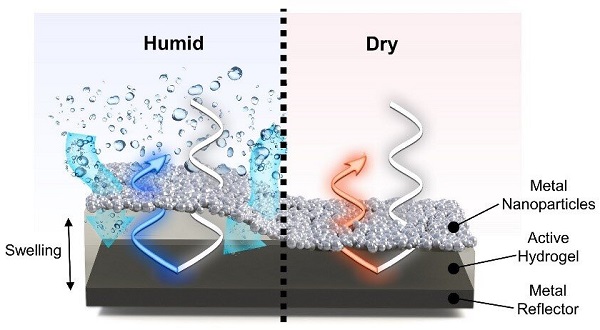The Hercules beetle native to South America has a fascinating trait of changing its shell colors depending on the external humidity conditions. This is because the inside of the beetle’s shell consists of porous lattice structure with square holes. When light of particular wavelengths hits the shell, it reflects them and displays different colors; and these wavelengths change depending on the humidity. Recently, a sensor that changes colors depending on the humidity like this beetle with 10,000 times faster speed than the conventional optical sensors has been proposed.
A POSTECH research team led by Professor Junsuk Rho (Department of Chemical Engineering and Department of Mechanical Engineering) and Ph.D. candidates Chunghwan Jung and Jaehyuck Jang (Department of Chemical Engineering), in collaboration with Sung-Hoon Hong and Dr. Soo-Jung Kim (Electronics and Telecommunications Research Institute, ETRI) and Professor Young Min Song (Gwangju Institute of Science and Technology, GIST), has developed an ultrafast humidity-responsive colorimetric sensor. The findings from the study were published in the top academic journal Science Advances.
Sensors using light are already being used in our daily lives, for electrocardiogram and air quality measurement. These sensors use light to detect changes in their surroundings and convert them into digital signals.
The research team fabricated a colorimetric sensor that consists of metal-hydrogel-metal structure using a disordered metal nanoparticle layer – a chitosan hydrogel – and a reflecting substrate. When the external humidity changes, the resonant frequency of the sensor changes due to the characteristic of the chitosan hydrogel that swells under wet state and contracts under dry state repeatedly.
This new sensor boasts an ultrafast speed that is 10,000 times faster than the conventional Fabry-Perot interferometer*1 based optical sensors. This fast reaction speed is thanks to the porous space between the nanoparticles that make up the sensor, much like the shell of the beetle that changes colors depending on the humidity.

Schematic diagram and the principle behind ultrafast full-color colorimetric humidity sensor.
“This new humidity sensor is special in that it allows scalability of production at low cost even though nanomaterials and nanostructures were used,” explained Professor Rho who led the study. “Introducing the humidity-responsive color pixels into security codes enables application toward security tags for humidity-sensitive electronic devices, banknotes, passports, and ID cards.
This study was conducted with the support from the Samsung Research Funding & Incubation Center for Future Technology.
Read the original article on Pohang University of Science and Technology.







